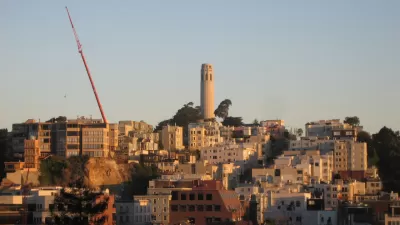'America 2013', a report released this week by the Urban Land Institute, presents the results of a nationwide survey on housing, transportation, and community preferences. Demographic trends indicate a continued demand for city living.
While some have expressed uncertainty about future trends in land use in the United States, if the current preferences of the Millennial Generation are a guide, compact development patterns are poised to lead the foreseeable future.
"A new report from the Urban Land Institute (ULI) underscores the influence that growing demographic groups in the U.S. – in particular Generation Y, African Americans, and Latinos – will have on reshaping urban growth patterns by spurring more development of compact, mixed-use communities with reliable, convenient transit service," writes Robert Krueger in a ULI press release announcing the findings of a recent nationwide survey.
"On the whole, the survey suggests that demand will continue to rise for infill residential development that is less car-dependent, while demand could wane for isolated development in outlying suburbs," he continues. "The survey found that among all respondents, 61 percent said they would prefer a smaller home with a shorter commute over a larger home with longer commute. Fifty-three want to live close to shopping; 52 percent would prefer to live in mixed-income housing and 51 percent prefer access to public transportation."
However, a post on The Wall Street Journal's "Developments" blog throws water on the study's findings. "Not everyone agrees with that theory," writes Kris Hudson. "Wendell Cox, a transportation consultant and demographer based in Belleville, Ill., says his analysis of census data shows that 76% of the growth in residents from 20 to 34 years of age from 2000 to 2010 came in low-density, often suburban counties."
Hudson also uses the opinions of two "random" Generation Y members to refute the report's findings.
FULL STORY: Where Americans Want To Live

Maui's Vacation Rental Debate Turns Ugly
Verbal attacks, misinformation campaigns and fistfights plague a high-stakes debate to convert thousands of vacation rentals into long-term housing.

Planetizen Federal Action Tracker
A weekly monitor of how Trump’s orders and actions are impacting planners and planning in America.

In Urban Planning, AI Prompting Could be the New Design Thinking
Creativity has long been key to great urban design. What if we see AI as our new creative partner?

King County Supportive Housing Program Offers Hope for Unhoused Residents
The county is taking a ‘Housing First’ approach that prioritizes getting people into housing, then offering wraparound supportive services.

Researchers Use AI to Get Clearer Picture of US Housing
Analysts are using artificial intelligence to supercharge their research by allowing them to comb through data faster. Though these AI tools can be error prone, they save time and housing researchers are optimistic about the future.

Making Shared Micromobility More Inclusive
Cities and shared mobility system operators can do more to include people with disabilities in planning and operations, per a new report.
Urban Design for Planners 1: Software Tools
This six-course series explores essential urban design concepts using open source software and equips planners with the tools they need to participate fully in the urban design process.
Planning for Universal Design
Learn the tools for implementing Universal Design in planning regulations.
planning NEXT
Appalachian Highlands Housing Partners
Mpact (founded as Rail~Volution)
City of Camden Redevelopment Agency
City of Astoria
City of Portland
City of Laramie



























